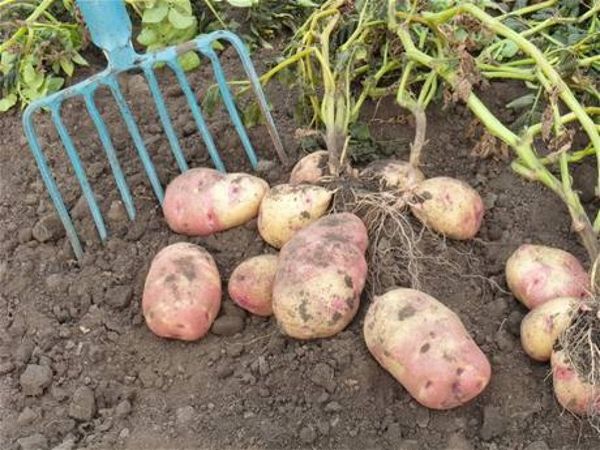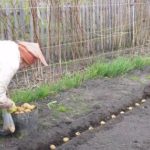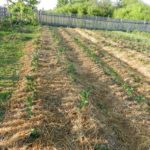Potatoes - unpretentious culture. With suitable soils, it is successfully grown even in cold climates. Productivity can be significantly increased with strict adherence to the rules of planting potatoes. Consider how deep and how many centimeters deep plant a culture.
Table of contents
Planting Rules
Despite the existence of hundreds of plant varieties successfully cultivated in our relatively cold climate, all they are demanding on the amount of light, moisture and soil quality.
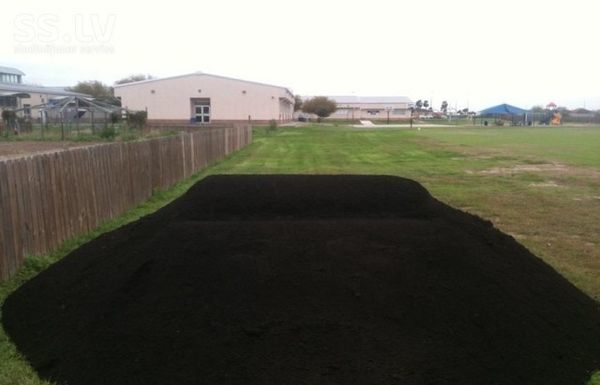
Correct depth
There are three options for placing potatoes in the ground, different planting depths:
- Small - no more than 6 cm; the method is used when the tubers are still in the cold ground, or the soil belongs to a heavy, loamy variety that is difficult to overcome by a sprout.
- Average - from 6 to 10 cm; ideal for areas with sandy soil.
- Deep - 12 cm or more; well suited for high-quality soils with high fertility, as well as for regions with a lack of natural moisture.
In the chernozem regions, they often practice medium and deep planting of potatoes. This is explained by the sufficient looseness of the earth (sprouts will easily find their way up), and early warming of the earth.
The depth for embedding is determined by the size of the tubers. If they are small (less than 50 g), then they should be placed slightly higher.
- Shallow depth of landing
- Average depth
- Deep landing
The distance between the bushes when landing
The main task is to determine the optimal depth of the wells - give the plant root system enough space for development. The distance from the neighboring tubers is no less important here.
It is desirable to use the space as efficiently as possible.
The optimal size of tubers for planting is not less than 50 g and a little more than 100 g. It is necessary to select seed material and prepare it for sowing long before work begins.
- Potatoes weighing less than 50 g - every 20 cm.
- Potatoes weighing 50-100 g - every 20-28 cm.
- Potatoes weighing more than 100g - every 28-40 cm.
Not only the size of the tuber, but also the development of the “peephole”, from which the roots grow, influences the scope of the root system. If there are many, and the location is spaced, then root system structure will come out especially lush. Each seed should have at least 2-3 eyes.
Distance between rows when landing
With the distance between the rows of plants the same as with the remoteness of the holes - the prosperity of the place ensures the rapid development of the plant, the weight of the stem increases, as a result, and the harvest.
The minimum allowable spacing is 60-70 cm, but here you should focus on the potato variety:
- Early maturing - 70-80 cm.
- Late-ripening - 80-100 cm.
The rule is valid for the most common planting patterns - along ridges and in trenches. For the first option, keeping the distance is especially important, since with a small distance of rows from each other, difficulties will arise with hilling, which sometimes needs to be done 2 times per season.
Although the placement of potatoes in the garden in all cases is done in rows, they themselves can be arranged in different ways.A popular experimental method is to plant in double rows with extended intervals between them.
With this scheme "Half-row" are located right next to each other - in some 20 cm, but the aisle is made meter instead of the usual 60-80 cm.
The scheme can be even more diversified if the bushes are arranged in a checkerboard pattern.
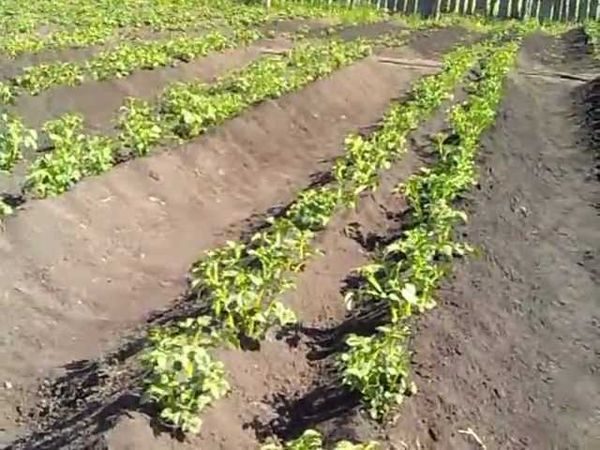
It can be calculated that the density of crops on the weave remains the same as in the classic version, but we get a lot of advantages - the best access of light from one side of the bush, ease of processing bushes, finally, the aesthetic appearance of the bed.
Tips for planting potatoes
Not all gardeners know that it is allowed to plant potatoes, not whole seeds, but cut into pieces. This is done either with a shortage of seeds, or with the excessive size of individual tubers.
Abuse the opportunity is not worth it, because plant viability from cuts weakens. It is also important to remember the following rules:
- Each part of a tuber must have at least 2-3 “eyes” of future roots.
- The cut seeds are planted only after the cuts are roughened - so they are less likely to fall ill.
- The minimum weight of a cut tuber for planting is at least 30 g.
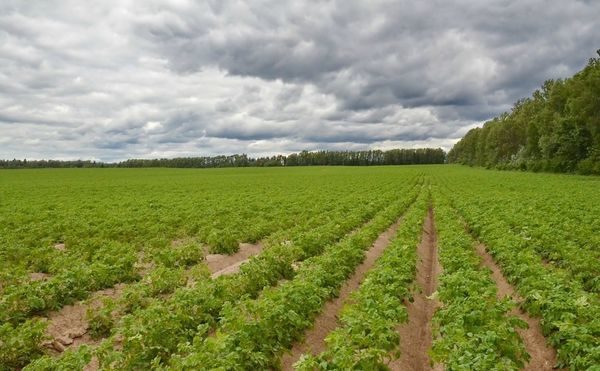
You can resort to two simple ways:
- To do a marking of a bed before landing - first mark the first row, in its place stretch the marker; the next ones are measured from the row, marking the landing zone on each furrow.
- As a guide use an ordinary board the length of the bed; as the next row is planted, the board is moved, trying to maintain the required distance by eye.
The methods are simple, but effective. With a flat landing on one weave of black soil should be placed from 350 to 500 bushes, depending on the size of the tubers.
Landing patterns: ridge and trench, furrow size
Different schemes of planting potatoes can help to more fully realize the quality of the soil and minimize its disadvantages. There are several of them:
- On the crest - the bed is formed in the form of rows of ridges elevated by 10-30 cm; thus, the tubers are located above the soil level.
- In trenches - potatoes are planted in shallow (5-10 cm) trenches filled with a fertile layer of humus, peat, sawdust in the fall.
These schemes are an alternative to the most common method - under the shovel. Though more labor intensive, they have a number of advantages.
Scheme how to plant potatoes in the garden and in the country
In addition to a richer harvest, complex schemes make it possible to fully take into account the climatic features of the region.
On the crest
At the top of them draw shallow grooves in which they plant potatoes. Wherein important to comb:
- was undulating, with rounded sides;
- in no case should it be triangular, otherwise the plant will germinate to the side, not up;
- such a landing is easier to pile up, it does not accumulate excess moisture in a rainy climate.
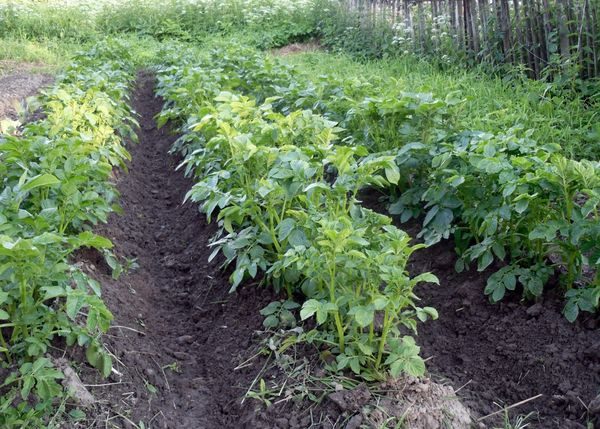
In trenches
Depth up to 30 cm, they are filled with fertile humus, in which the tubers are placed; water is better accumulated in trenchestherefore, the method is optimal for regions with arid summer.
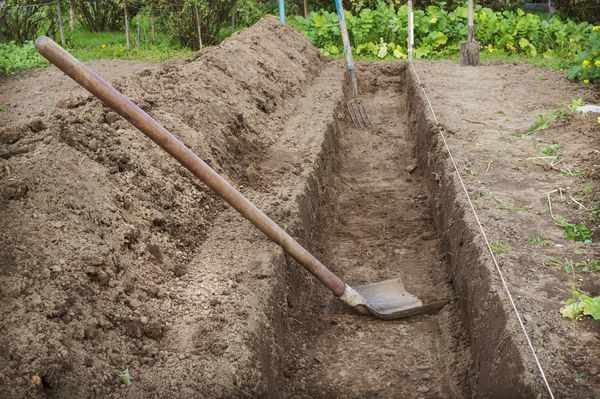
On organics in a container
Nutrients are better stored in the box, the fertile layer can be changed every year; the ground warms up faster in spring, because the scheme allows for the planting of early ripening varieties; The scheme is indispensable for cold northern latitudes.
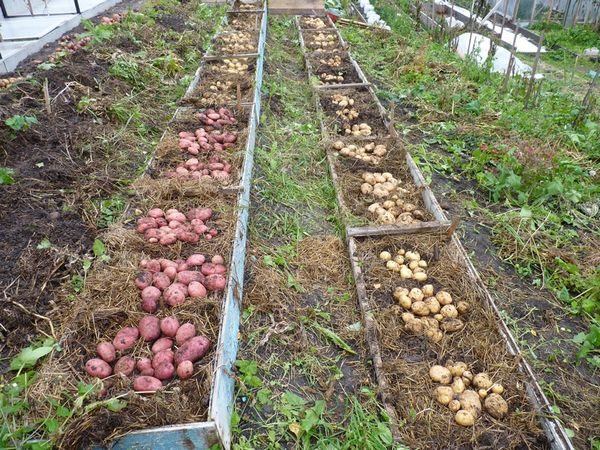
Landing depth when using complex schemes
Equally important is the depth of laying seeds and plays with complex schemes. The process can begin, when the soil temperature warms up to 8 ° C. Consider the nuances and what the depth of the hole:
- On the ridge - in the hills heated from three sides, the temperature rises faster; the depth of the tuber depends only on the soil - on loam no more than 6–8 cm, and on black soil and sandy soil - 8-10 cm.
- In trenches - it is important to properly maintain the depth of the trenches themselves, wait for the fertile layer filling them to shrink and a recess of no more than 5 cm is formed; in him and put the seed.
- On the organics in the container - as on the beds in the form of ridges, can be put in containers earlierThe depth is shallow - 6–8 cm.
Organic containers are recommended to be installed in the north-south direction, which gives the plants more light.
How to plant potatoes under the shovel
Despite the growing interest in more complex methods of forming beds, planting potatoes under a shovel was and remains the most common option. This “grandfather's” way of planting by hand, though simple, also requires some knowledge from the gardener.
By how many centimeters deep
The method is simple shovel equipment - a hole is made in the ground for embedding, half the length of the blade, i.e. the same 10-12 cm.
The classical arrangement of tuber placement with a spade method is 70 cm between the rows (borax) and 30 cm between the holes.
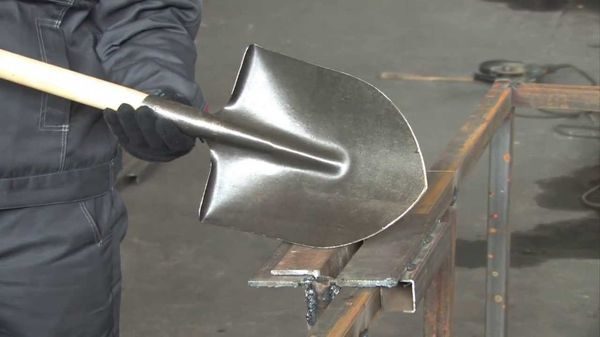
What need a shovel for planting potatoes
The most convenient to work on the beds type of shovel - bayonet. Its blade is made in the shape of a rounded petal. The material used is high-strength metals - tool steel, or even titanium.Standard blade sizes:
- Length - 32 cm.
- Width at the base - 23 cm.
There are also non-standard options, as a rule, their size varies in a larger direction than normal.
How does the landing without a shovel
When preparing the beds, you can completely do without the entrenching tools. First, earthworks are faster performed using a garden plow, but the method is good only if you plant potatoes in furrows.
Afterwards this will require time-consuming hilling.
- Potatoes under hay
- Under the straw
The choice of gardeners have many options to plant potatoes professionally or in the country. Let the plant belong to the most common and tolerant of harsh conditions, it no less than others requires human effort and effort during cultivation.
